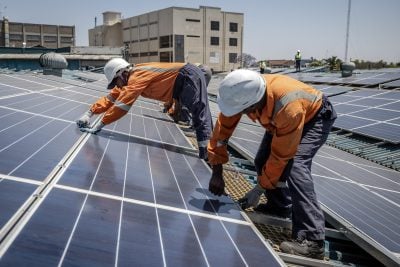Carbon trading, so long a frustrating collision of economic elegance and implementation nightmare, is back.
Just two years ago both popular media and academic publishing were replete with titles like Putting A Price On Carbon: It Was Hot, Now It’s Not and the rather more pointed Why Carbon Pricing Is Not Sufficient to Mitigate Climate Change. Meanwhile the Cop27 climate summit at Sharm El-Sheikh in Egypt saw the launch of two new large carbon trading schemes, alongside a host of other initiatives designed to make such trading easier.
According to Shell – an enthusiastic proponent of carbon trading – voluntary carbon markets are anticipated to become at least five times bigger by 2030. By then they could potentially be transacting volumes of credits equal to the entire 2019 emissions of the aviation industry. The consultancy McKinsey is going bigger still, projecting growth by 2050 of up to 100 times the amount of credits currently traded.
The list of critiques levelled at carbon trading is long – and would not bear repeating, except to remind us of the scale of the pickle in which we may soon find ourselves.
First, carbon markets are fiendishly complicated. Overlapping jurisdictions, rates, bases, prices and verification methodologies bury good ecological intentions under an unyielding morass of detail.
According to one review, at year-end 2019 there were no fewer than 21 regional emissions trading schemes in place around the world, with another 24 under consideration at the city, state or regional level. Then there are the big national schemes, of which the EU and Chinese versions are the largest, but which also exist in nations such as New Zealand, Korea and Japan.
Second, carbon markets are abstract and hegemonic. They seek to render infinitely complex biophysical processes into a simple ledger amenable to Western science and finance. This sounds like a drastic charge, potentially even a disingenuous one, but the efforts of Rowan Foley and others at Australia’s Aboriginal Carbon Foundation to escape the constraints of simplistic “carbon in versus carbon out” accounting shows just how colonial, loaded, repressive and frankly inaccurate such hierarchical knowledge systems can be.
Glossing over, or directly subordinating, alternate forms of knowledge, value and relations to the natural world is inescapable where environments and the communities who live and work inside them must be made legible to carbon traders in London, New York, Singapore or Geneva.
Thirdly, and most critically, carbon trading doesn’t seem to work. As our chart of annual world greenhouse gas emissions shows, albeit crudely, the carbon trading era – commencing with the start of the EU Emissions Trading Scheme (ETS) in 2005 – has accompanied continued rises in global emissions.
It is true that emissions may be increasing more in places that are not covered by emissions trading schemes. It’s also impossible to be sure that a world without carbon trading wouldn’t be much worse than this one. But it’s worth noting that the only time emissions have actually properly fallen since 2005 was in 2019-20, when the Covid-19 pandemic swung a sledgehammer through the global economic system.
And herein lies the point. While carbon trading may be a useful concept, or even an effective tool – if we could get the measurement, economics and implementation right – it is clearly not a systemic solution to a systemic problem.
“Framing the climate challenge as a market failure”, wrote Daniel Rosenbloom and colleagues in 2020, “fails to seriously appreciate its scope and depth… Core societal functions, such as heating or mobility, are met through large and deeply entrenched sociotechnical systems made up of interconnected technologies, infrastructures, regulations, business models, and lifestyles… these systems have become increasingly locked into the combustion of fossil fuels and the associated release of GHG emissions.”
For these authors, climate change can only be addressed through “fundamental changes to existing systems” – something that carbon trading was never intended to achieve. Indeed, its ability to marry business-as-usual with some kind of emissions reduction was precisely the point when Ronald Coase first posited the founding concepts in 1960.
That an efficient allocation of environmental costs and benefits could come about by a polluter simply buying the credits required to keep polluting was a core implication of the proposal. This likely accounts for the world’s largest participants in carbon trading in 2021 including airlines, fossil fuel giants and car companies. The largest by a long way was a cryptocurrency platform that bought up masses of credits in order to tokenise them.
Considered this way, the resurrection of carbon trading at Cop27 makes perfect sense. This was, after all, the Russia-Ukraine Cop, the gas Cop, the enmity Cop; the Cop taking place amidst worldwide energy market meltdown, macroeconomic pain, crisis fatigue, canyoning trust and the shuddering realisation of just how much things would have to change if the climate crisis were to be taken seriously. For some of the attendees – who included an unprecedented contingent of fossil fuel lobbyists – a feeble, convoluted, financialised solution may be just what the doctor ordered.
This is an IC Intelligence article, written for African Business.
Want to continue reading? Subscribe today.
You've read all your free articles for this month! Subscribe now to enjoy full access to our content.
Digital Monthly
£8.00 / month
Receive full unlimited access to our articles, opinions, podcasts and more.
Digital Yearly
£70.00 / year
Our best value offer - save £26 and gain access to all of our digital content for an entire year!

 Sign in with Google
Sign in with Google 



